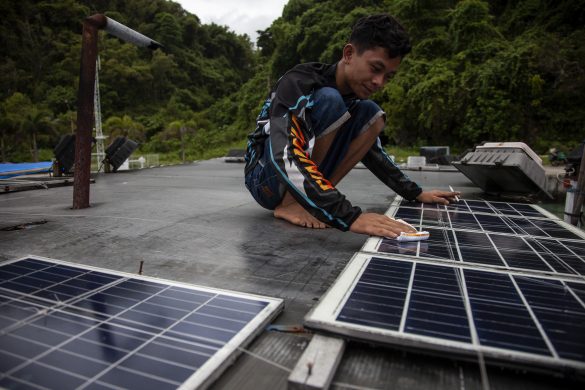KOMMENTAR / ANALYSE
Af David McKenzie
seniorøkonom i Verdensbanken
blog bragt på bankens website 09.05.11 (Fighting Malaria with Microfinance?
Diseases like malaria, diarrhea and intestinal worms (indvoldsorm) plague hundreds of millions of people in the developing world.
A major puzzle (gåde) for development researchers and practitioners is why the poor do not purchase available prevention technologies that could reduce the burden of these diseases.
While much of the recent literature has focused on price elasticities of demand and behavioral explanations, another potential explanation is that liquidity constraints (mangel på kontanter) prevent the poor from undertaking profitable health investments.
If this is the main barrier, microfinance could potentially help overcome it.
A new experiment in Orissa, India conducted by Alessandro Tarozzi, Aprajit Mahajan and four other researchers tests whether micro consumer loans can increase adoption of insectide-treated bednets and improve health outcomes, and compares these effects to those achieved with free distribution. Key details are as follows:
Context:
Villages in rural Orissa, India in which BISWA, a micro-lender, was already operating. Orissa is one of the poorest states in India and the state with the highest incidence of malaria.
About 20 per cent of individuals in the study tested positive for malaria. So following the criteria in my external validity rant, this seems an appropriate and interesting location for such a study.
Sample:
141 villages, randomized at the village level into 3 groups of 47 villages each. 15 households per village who were existing BISWA clients were then randomly (tilfældigt) selected to be interviewed (although the intervention was done with all BISWA clients, which constitute about 20 per cent of the households in the village). Total baseline sample is 1.844 households with 10.062 individuals.
Interventions:
Villages were randomly allocated into control, micro-loans, and free distribution. All three groups got a brief information session on malaria prevention.
BISWA households in the free treatment villages received at no cost a number of betnets determined by their household compostion; BISWA households in the micro-loan treatment villages were offered contracts for purchase of bednets and re-treatments of insecticide using consumer loans at 20 per cent (the lender’s standard interest rate) with a one-year repayment period.
Bednets in the loan treatment were at market prices, about the cost of 20 kg of rice.
Timing:
Impacts were measured at between 1 year and 18 months after treatment.
SO WHAT DID THEY FIND?
* The Good: 52 per cent of households in the micro-loan treatment purchased at least one bednet, almost all on credit (despite the option to pay cash).
* The not-so-good: take-up and usage of bednets in the micro-loan villages fell well short of those in the free distribution villages: At follow-up, 16 percent of individuals in micro-loan villages used a treated net the previous night, vs 2 percent in control villages and 47 percent in free-distribution villages.
* The surprising bad news – no health improvements: neither micro-loans nor free distribution led to reductions in the proportion of individuals infected with malaria, nor to reductions in anemia prevalence (graden af blodmangel). Both were measured using rapid diagnostic tests which took small blood samples.
This is a relatively precise zero with the point estimates actually giving slightly (but not significantly) higher prevalence levels in treated areas.
* The other bad news for microfinance: These were one year loans. At follow-up 1-1,5 years later, only 49 per cent had been repaid in full, and 20 per cent of households with loans had not repaid anything.
WHAT IS GOING ON?
The authors examine several explanations for the lack of a health effect.
They conclude that the most likely reason is that the distribution programs did not achieve sufficient village-wide coverage (they were only offered to BISWA clients) or sufficient regular usage (there were not intensive follow-ups to encourage usage), to break the cycle of malaria transmission – as with the studies of worms, the externalities from others really matter here.
Note also that the study gives an upper bound on how much difference micro-finance can make – since the study also effectively is a supply intervention as well, by directly marketing the bednets to households in the treated villages but not directly marketing them to households in the control villages, the authors can not separate how much is due to liquidity constraints vs this additional marketing effect.
On one hand the fact that 52 per cent of treated households actually borrowed to take a net is really high, and potentially encouraging for micro-finance.
But these were all existing BISWA clients – microfinance borrowers in many places might do anything their lender tells them or suggests that they do, either because the microfinance organization has built up trust, or because the borrowers think it will help them in getting future loans.
We know that take-up for microfinance in the general population tends to be quite low in many places. Given this, it seems microfinance alone is unlikely to be enough for diseases in which collective action to break externalities matters.
I would be interested to know whether micro-loans have more potential for health technologies which work well even if you are the only one in the village using them?
(slut)
——–
The blog is maintained by four researchers from the Development Research Group of the World Bank. Its aim is to cover all things related to impact evaluations. Bloggers are Berk Özler, David McKenzie, Jed Friedman and Markus Goldstein.
New Zealand-born David McKenzie is a Senior Economist in the Finance and Private Sector Development Unit of the Banks Development Research Group.
Kilde: www.worldbank.org














